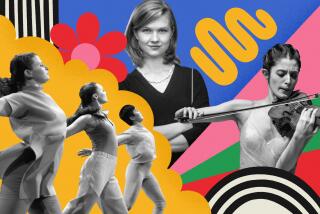MUSIC REVIEW : Dutch Soprano Elly Ameling Works Her Magic Again
- Share via
Utterly sovereign in her art, abundantly resourceful in her craft and beloved by her fans, Elly Ameling continues to uphold the endangered tradition of the song recital in her annual visits to our concert halls.
The Dutch soprano returned to Ambassador Auditorium on Thursday night and worked her familiar magic again.
In a mixed program of lieder, melodies and two arias by Mozart, Ameling created vignettes, cameos and complete characterizations with her vocal and facial resources alone. She remains the model recitalist, a witty and pointed storyteller in song, the maker of instant dramas.
Of course, she was admirably assisted by pianist Rudolf Jensen in this generous but compact survey of music by Haydn, Mozart, Schubert, Brahms, Mendelssohn, Wolf, Schumann, Joseph Marx, Richard Strauss, Gounod, Faure, Caplet, Poulenc and Duparc. These were single items mostly, but tied together in subtle textual and musical ways; even with her adoring audience insisting on applause between each song, Ameling’s program did not seem long (naturally, she is too sensitive an artist to squelch the enthusiasm of a crowd).
However accurate, it would be a cliche to say that every item on this agenda became a gem. One can say, however, that every moment rang true, that the communication between stage and auditorium never faltered, that sincerity and directness informed every musical and vocal gesture.
If one has to identify high points, some of them were: Brahms’ “Feldeinsamkeit,” in which was created a sense of complete contentment in an atmosphere of buoyancy; Marx’s sensuous “Nocturne,” given a deep voluptuousness of both word and sound; Gounod’s “Viens! Les gazons sont vert!” wherein the urge to gambol threatened to infect the at-that-moment rain-bound denizens of Ambassador Auditorium.
Similarly peerless was Ameling’s affecting performance of two contrasting arias from “Le Nozze di Figaro,” “Deh vieni, non tardar” and “Dove sono,” which became object lessons in legato singing, poignant word-coloration and rich and exquisite shading of dynamics.
At this point--the end of the program proper--the audience showed no willingness to leave the premises. For their stubbornness they were rewarded with three encores: Obradors’ “Del cabello mas sutil”; Schubert’s “Seligkeit,” and Stravinsky’s “Pastorale.”
More to Read
The biggest entertainment stories
Get our big stories about Hollywood, film, television, music, arts, culture and more right in your inbox as soon as they publish.
You may occasionally receive promotional content from the Los Angeles Times.










